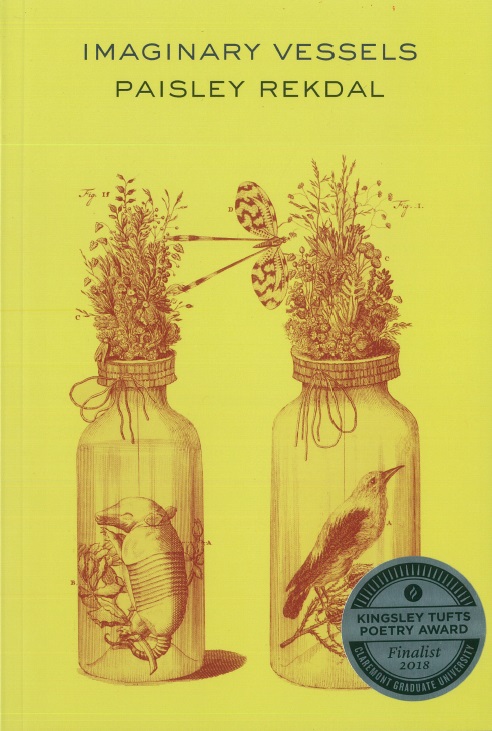A Reckoning (from Paisley Rekdal’s Imaginary Vessels)

Paisley Rekdal is a deceptively readable poet. This is because she most often writes narratively. In her poetry volume Imaginary Vessels, (a finalist for the 2018 Kingsley Tufts Poetry Award), Rekdal leverages the sentence—as we know it, and thus Rekdal’s poetry is prosaic. In fact, she often goes so far as to provide both setting and characters. For example: “In the courts and on the boards, Mae sways/ and shimmies…” (from “Censored”). These choices make meaning more readily available to those untrained in poetry. According to modern cognitive science, many linguists and psychologists believe that the narrative is an absolute universal, rather than a merely implicational or statistical universal. This means that to be human is to recognize the narrative structure: both at the level of overall rhetorical organization and sentence. Rekdal wisely—brilliantly—capitalizes on the recognition, not (always) to tell stories, but instead to narrate (sometimes imaginary) experiences and induce contemplation.
The first means of navigation Rekdal provides is structural. To read “Imaginary Vessels,” a working knowledge of the sonnet is not required: merely, one must be able to read a sentence. However, Rekdal’s relationship with sentence and “plot” is not one of strictures. There are certainly variations; “Go West” is a poem created from an assemblage of slang words, arranged on the page a bit like Magnetic Poetry on a fridge. But in most of Rekdal’s poetry, syntax is intact but loosened. When she writes “…It hurts// to imagine it, regardless/ of the harvester’s/ denials, swiveling// his knife to make/ the incision: one/ dull cyst knicked// from the oyster’s mantle—…” (from “Vessels”) the subject/predicate organization is still instructive. At a basic level, there is an actor, an action, and requisite modifiers. For simple comprehension, the stanza breaks and meter are secondary to the grammar. In fact, in an interview, Rekdal explains her choice to use conventional syntax and narrative structure as a means of producing coherence. To her, narrative is a “political stance,” which reflects her “cohesive” but “complex” identity and life as a bi-racial woman. Rekdal’s reliance on structure is a resistance to “post-modern” fragmentation.
Usually, Rekdal can be relied upon to use the sentence as a conceptual structure, and so when she deviates somewhat, the disruption does not produce incoherence. Rather, the disruptions result in innovation. For example, Rekdal often interrupts her own thoughts with a colon, but she does not always do so in conventional ways. “…That’s my nameplate, calling card: fat man, drunkard, turnip-/faced: rage’s endless hectoring joke” (from “W.C. Fields Takes a Walk”). First, the colon seems to convey the usual: words following the punctuation expand upon, explain or modify the sentence preceding. But the second colon is Rekdal’s poetic invention and converts the entirety sentence once added. Any object in the sentence could be “rage’s hectoring joke.” Or, the invectives (“fat man, drunkard, turnip-faced”) could be an interruptive statement partitioned off by colons instead of dashes, which are parallel grammar with the colon. Either way, the beginning of the sentence is commented upon–at least once, maybe twice–and/or expanded upon in the second half. We must return to the beginning to recalibrate the meaning. Rekdal strongly relies upon our knowledge of grammar; she conforms, then transgresses, and so we will scramble to make sense of her new rules in the wake of the breakage so as to restore order.
The structural choices Rekdal makes are not, however, limited only to her sentences. As Jonathan Farmer pointed out in his review of Imaginary Vessels, many of her poems contain themes and motifs arranged in a way very similar to those that organize and animate prose. The second poem in the volume, “Bubbles,” illustrates a scene wherein mother and child sit with the narrator in the park. The child blows bubbles, and the narrator meditates upon the ephemeral nature possibilities: the theme works through the motif, much in the way of story stories. In broader strokes, the section of the volume entitled “West” works through Rekdal’s character portraiture and memoir of Mae West. In the section entitled “Shooting Skulls: a Wartime Devotional,” Rekdal uses estrangement techniques to humanize and specify the tragedies represented by the bodies found under the Colorado Mental Health Institute. Though the sections of Imaginary Vessels are seemingly disparate, unlike the chapters of a novel, the textures of her explorations will be familiar to book readers. Rekdal is a lyricist who likes to stage her wonderings, and her props are often borrowed from the world of narrative.
Whether she intended to widen her audience or not, Rekdal’s choices offer grand possibilities for poetic readership. A friend once explained to me that the problem with poetry is the barrier to entry. He meant that poetry can be difficult to understand. The observation, I feel, is merited. Poetry leaves many traditionally formal writing requirements optional. For this reason, poetry is both prized and reviled: without the ability to predict formal choices, interpretation and criticism must become creative. Meaning expands with new, non-definitive possibilities. The previously un-expressible finds a way. But if poetry is language unshackled, we must remember why we constrained it in the first place. Without rules, more choices become available. But those choices are often unprecedented, and thus they require ciphering. Must a reader always be a detective? If the answer is no, the possibility of reading for mere pleasure remains available, and that is what Rekdal offers in scads.
—Kelly Eisenbrand
Share